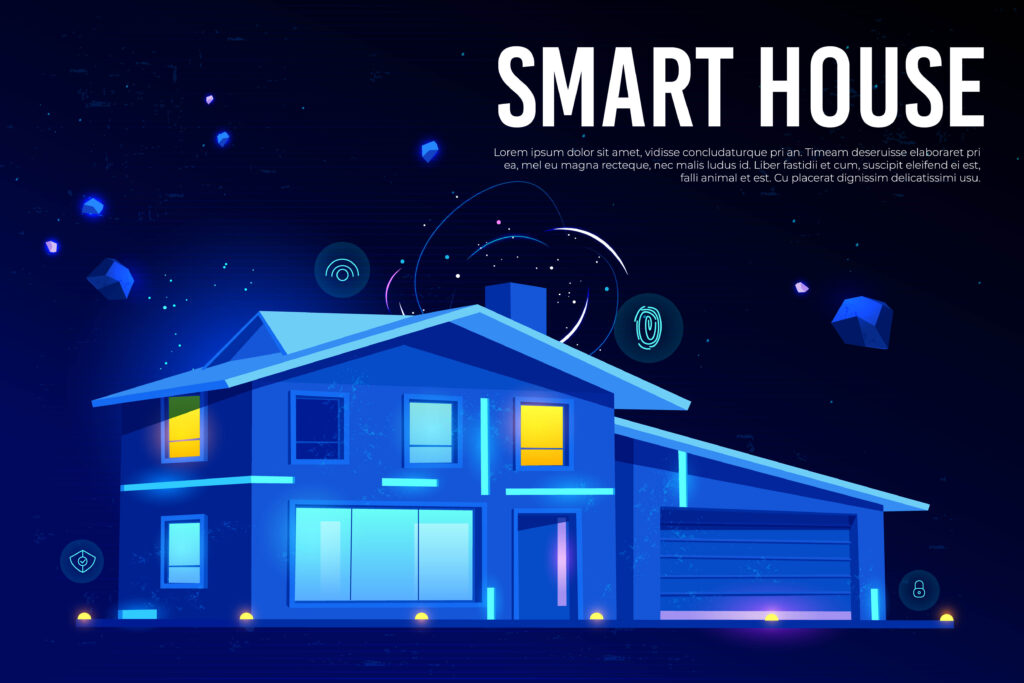Smart Home Design: Enhancing Comfort and Efficiency
In today’s fast-paced world, the concept of a “smart home” has evolved from being a luxury to becoming a necessity. Smart home design integrates technology into our living spaces, making our daily lives more convenient, efficient, and comfortable. This article delves into the exciting realm of smart home design, exploring its benefits, key features, and considerations.
Introduction
The idea of a “smart home” stands as a beacon of creativity and pragmatism in a time when our lives are lived at an ever-increasing pace and are characterized by technology breakthroughs. Science fiction has given way to reality in terms of the idea of a house that not only protects us but also intuitively adjusts to our needs, wants, and routines. Welcome to the realm of smart home design, where modern technology melds with home comforts to improve daily life.

This essay takes readers on a fascinating tour into the world of smart home design, examining its many advantages and the crucial part it plays in our modern lives. Smart home design is no longer a luxury but a necessity because of the extreme convenience of voice control across the house, the observable environmental benefits of energy conservation, and the profound sense of security it provides.
As we delve into the details of this interesting field, we will identify the essential elements, provide helpful starting point recommendations, and expose the emerging trends that have the potential to alter what we mean when we say “home”.
The Essence of Smart Home Design
Smart home design involves the integration of various smart devices and systems to enhance the functionality and efficiency of your home. It’s all about making your life more comfortable and convenient while reducing energy consumption and improving security.
Benefits of Smart Home Design
Enhancing Convenience
Smart homes offer unprecedented convenience. Imagine controlling your lights, heating, and entertainment systems with a simple voice command or through your smartphone. You can even check who’s at your front door from your office or adjust your thermostat while on vacation.
Increasing Energy Efficiency
One of the most significant advantages of smart home design is energy efficiency. Smart thermostats, lighting, and appliances help you reduce your carbon footprint and lower energy bills by automatically adjusting settings based on your usage patterns.
Improving Security
Smart home security systems provide peace of mind. With real-time surveillance cameras, smart locks, and motion sensors, you can monitor your home remotely and receive instant alerts in case of any suspicious activity.
Key Components of a Smart Home
Smart Lighting
Smart lighting systems allow you to customize the ambiance in each room, save energy by automatically turning off lights, and even sync with your daily routine to simulate natural light patterns.
Home Automation
Home automation systems connect and control various devices, from thermostats to coffee makers. These systems create scenarios where your home adapts to your needs automatically.
Voice Assistants
Voice-controlled virtual assistants like Amazon Alexa and Google Assistant have become integral parts of smart homes, letting you control your devices and get information with simple voice commands.
Integration and Compatibility
Before diving into smart home design, ensure that the devices you choose are compatible with each other. An integrated ecosystem makes it easier to control your entire home with a single app or voice command.

Designing a Smart Home: Where to Start
Assess Your Needs
Determine your goals for your smart home to get started. Which do you value more: security or energy savings? Your design will take after your goals.
Create a Budget
Smart home design can range from affordable to extravagant. Set a budget that aligns with your goals and prioritize the most important components.
Choose the Right Devices
Select smart devices that align with your lifestyle. For example, if you love cooking, invest in smart kitchen appliances. If security is paramount, focus on robust security systems.
Seek Professional Help
Complex installations may require professional assistance. Don’t hesitate to consult experts in smart home design to ensure everything runs smoothly.
Designing Smart Bedrooms
Create a bedroom oasis with smart lighting that gradually brightens in the morning, and a thermostat that adjusts to your preferred sleep temperature.
Transforming the Living Room
In the living room, smart TVs, sound systems, and automated window blinds can elevate your entertainment experience.
Revolutionizing the Kitchen
Smart kitchen appliances, such as refrigerators that suggest recipes and ovens you can control remotely, streamline meal preparation.
Creating Intelligent Bathrooms
Smart bathrooms offer features like heated floors, touchless faucets, and mirrors with built-in displays for news updates or makeup tutorials.
Smart Home Exterior Design
Enhance your home’s curb appeal with smart outdoor lighting, automated sprinklers, and security cameras.
Privacy and Security Considerations
Protect your data and privacy by securing your Wi-Fi network, using strong passwords, and regularly updating your smart devices’ firmware.
Maintenance and Upkeep
Regularly update and maintain your smart devices to ensure they continue to function optimally. Firmware updates often include security patches.
Future Trends in Smart Home Design
The world of smart home design is ever-evolving. Look out for future trends like augmented reality home tours and even more energy-efficient solutions.

Conclusion
Smart home design is a reflection of human ingenuity and the need for a more comfortable, effective, and secure way of life in the vast tapestry of our modern world, where innovation is the driving force and convenience is the currency. One thing becomes very evident as we come to a close with our investigation of this astonishing idea: the future is smart, and it starts at home.
We have the ability to turn our living spaces into dynamic, responsive settings that accommodate all of our needs thanks to the smart home technology at our disposal. The possibilities are endless, from beds that gently awaken us to living rooms that serve as entertainment centers, from kitchens that speed meal preparation to baths that provide opulent touches. However, with tremendous power comes great responsibility, and we must not undervalue the significance of continuing maintenance, security, and privacy.
A future where our homes are more than just physical structures and become our allies in the pursuit of a better, more comfortable existence is promised by smart home design, which is a journey rather than a final goal. So, as we enter this brave new world of smart homes, let’s embrace its revolutionary potential and set out on a path to a day when our houses are genuinely inventive rather than just smart.
FAQs
- What’s the first step in designing a smart home?
- Assess your needs and determine your priorities, whether it’s convenience, energy savings, or security.
- Are smart home devices compatible with each other?
- It’s crucial to choose devices that are compatible to create a seamless smart home ecosystem.
- Can I install smart devices on my own?
- While some installations are DIY-friendly, complex setups may require professional help.
- What are the benefits of smart lighting?
- Smart lighting allows you to customize your home’s ambiance, save energy, and sync with your daily routine.
- What does the future hold for smart home design?
- The future promises even more innovative solutions, such as augmented reality home tours and enhanced energy efficiency.
Most Related Post : Smartify Your Life with Google Home Hub Charcoal



